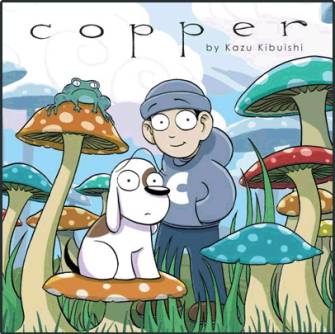 Home > CR Reviews
Home > CR Reviews Copper
posted January 28, 2010
Copper
posted January 28, 2010

 Creator:
Creator: Kazu Kibuishi
Publishing Information: Scholastic, hardcover/softcover, 96 pages, January 2010, $14.95/$9.95
Ordering Numbers: 0545098920 (ISBN10 -- HC); 9780545098922 (ISBN13 -- SC); 0545098939 (ISBN10 -- SC); 9780545098939 (ISBN13 -- SC)
The thing I like about Kazu Kibuishi's irregular and I think until now primarily if not entirely on-line comic strip
Copper is that it's old-fashioned. By old-fashioned I don't mean that it's all-ages or targeted to a specific kind of fantasy audience that makes one think of classic comics works, although it is those things. What I mean is that rather than a high concept tied into some element of the current zeitgeist,
Copper makes its own amiable way. There's little
insistence here, almost nothing in the way of acting on its own self-awareness or pursuing a specific thematic agenda. It's a fine tonic to those strips where you can feel the grind of a brand being advanced.

In many
Copper installments, Kibuishi presents his two characters noodling around some sort of slightly difficult, challenging but not hugely dangerous, landscape. The characters tend to have a goal in mind -- cross this area, explore this construct, ride this wave -- that may or may not seem important but never feels like it controls the moment. This free pass allows you to luxuriate in Kibuishi's pleasing cartooning, and also to relax for a time in the ease of a comic made up of characters poking around the page. It's a way of reading comics that's mostly missing now, one that depends on the act of processing comics itself as a pleasurable activity, and I think would be welcome on a newspaper page even now.
It's interesting to have the work all in one place, one that you can drag around the house with you. You get to better appreciate Kibuishi's ability thus far to provide variations on a theme. Some of the more arch and cryptic episodes stand out, as does an early motif of dreaming that's largely been abandoned. There's an admirable modulation that Kibuishi provides the characters -- he doesn't have the modern strip's impatience with defining each one's personality and goal so that it can be picked up by the densest, most casual reader -- that pays off in terms of letting you discover their basic outlooks on life rather than immediately sitting in judgment in terms of how each type is portrayed. I do regret that the book isn't bigger, lusher, more evocatively designed. Kibuishi has developed a fine enough kids' audience through his
Amulet that a straight-forward presentation should work just fine sales-wise, but kids like beautiful things, too, and I'm not sure the pleasure of the visuals comes through all that well given the choices of dimension and paper stock.



